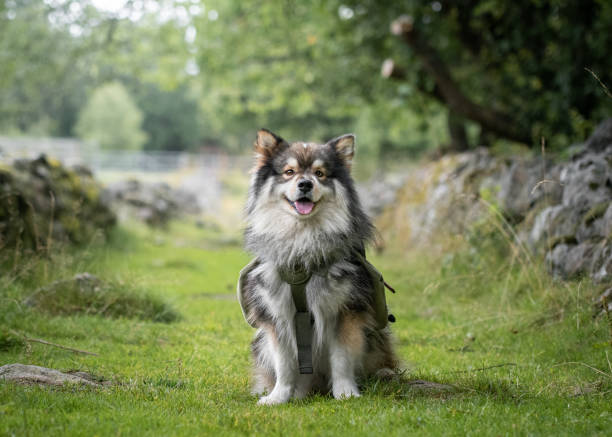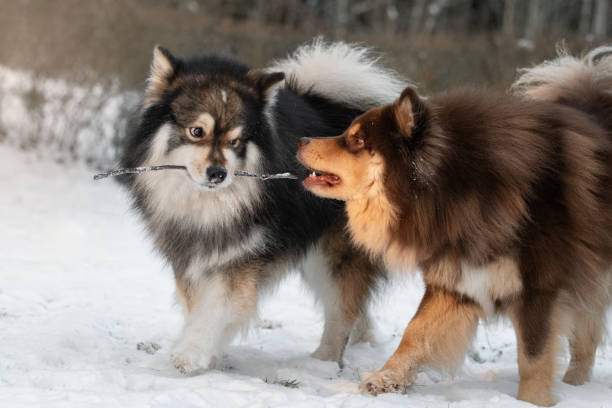Finnish Lapphund

Breed History:
The Finnish Lapphund is a hardy, intelligent herding dog developed by the Sámi people of Lapland in northern Finland. Originally bred to herd and guard reindeer in arctic conditions, this ancient spitz-type breed has a long-standing role as a working companion in harsh, snowy environments. Its calm demeanour, agility, and resilience made it ideal for managing large herds across frozen terrain.
The breed faced decline with modernising herding methods, but was preserved through focused breeding efforts in the 20th century. Officially recognised by the Finnish Kennel Club in the 1940s, the Finnish Lapphund has since gained popularity across Europe and beyond for its friendly temperament, striking appearance, and adaptability.
|
Gender |
Height |
Weight |
|
Male |
46-52 cm |
18-24 kg |
|
Female |
41-47 cm |
16-20 kg |
Size – Medium
Life Expectancy: 12–15 years

Breed Appearance:
The Finnish Lapphund has a beautiful, thick double coat suited for cold climates, with a soft, dense undercoat and longer, harsher outer hair. It features a mane-like ruff around the neck, especially prominent in males. The breed comes in various colours, including black, brown, sable, and cream, often with lighter markings on the face, chest, and legs.
With a strong, compact build and a distinct spitz-like tail that curls over the back, the Lapphund maintains a balanced, athletic appearance. Its expressive oval eyes and intelligent, alert expression highlight its working dog heritage, while its overall structure supports agility and endurance.
Breed Type – Family/Herding:
Originally bred for herding reindeer, the Finnish Lapphund is a natural herder with a calm and cooperative nature. It is deeply affectionate and forms close bonds with its human family, making it a loving and loyal companion. Known for its friendliness, the breed is usually gentle with children and gets along well with other pets when properly socialised.
Despite its herding instincts, the Lapphund is not aggressive or overly dominant. It is alert and vocal, often quick to bark at unfamiliar sounds or visitors, making it an effective (but non-aggressive) watchdog. The breed thrives in an interactive family environment and prefers not to be left alone for long periods.

Training:
The Finnish Lapphund is intelligent, eager to learn, and responsive to positive training methods. It enjoys mental stimulation and tends to pick up commands quickly, making it suitable for obedience, agility, and other dog sports. Consistency and encouragement are key, as the breed can become bored with repetitive or overly harsh training.
Because of its working background, early socialisation and training are essential to build confidence and prevent excessive vocalisation. While naturally well-mannered, the Lapphund benefits from structured activities and routines that give it a sense of purpose and mental engagement.
Health & Care:
Generally, a healthy and robust breed, the Finnish Lapphund has relatively few major genetic concerns. With proper care, it enjoys a long and active life. Some health conditions to watch for include:
-
Hip dysplasia
-
Progressive retinal atrophy (PRA)
-
Cataracts
-
Elbow dysplasia (less common)
Routine veterinary visits, a balanced diet, and regular exercise are essential to maintaining optimal health. As with many northern breeds, the Lapphund does best in cooler climates and may need extra care in warm weather to prevent overheating.

Living Conditions:
Adaptable and resilient, the Finnish Lapphund can live comfortably in various environments, from rural farms to urban homes. While it appreciates outdoor space and enjoys time outside, it can adapt to apartment living as long as it receives sufficient physical and mental exercise.
The breed prefers to live close to its family and does not tolerate long periods of isolation well. A home with regular interaction, secure outdoor access, and a moderate climate is ideal. While it can be vocal, proper training and stimulation help manage barking tendencies.
Exercise:
Active but not hyper, the Finnish Lapphund enjoys regular exercise and thrives with daily walks, playtime, and training sessions. It is agile and enjoys off-leash running in safe, enclosed spaces. Activities like hiking, herding trials, and agility courses are excellent for channelling its energy and instincts.
Without enough activity, the Lapphund may become restless or vocal. At least an hour of varied physical and mental exercise per day is recommended to keep the dog healthy, happy, and engaged.
Grooming:
The Finnish Lapphund’s thick coat requires regular maintenance. Weekly brushing is sufficient during most of the year, but daily grooming is needed during seasonal shedding periods (spring and autumn), when it sheds heavily. A slicker brush and undercoat rake help remove loose fur and prevent matting.
Bathing should be done occasionally, using a mild shampoo that preserves the coat’s natural oils. Other grooming needs include regular nail trimming, ear cleaning, and dental care. The breed is relatively clean and does not have a strong odour despite its dense fur.

Advantages:
-
Friendly, gentle, and loyal companion
-
Intelligent and eager to train
-
Excellent with children and other pets
-
Well-suited to cold climates and outdoor living
-
Adaptable to various home environments
-
Naturally clean and relatively low-odour for a double-coated breed
Disadvantages:
-
Heavy seasonal shedding requires regular grooming
-
Can be vocal, especially if bored or under-stimulated
-
May develop separation anxiety if left alone frequently
-
Sensitive to heat due to its thick coat
-
Needs regular exercise and mental engagement to prevent restlessness
-
Herding instincts may cause occasional chasing or barking without proper training

